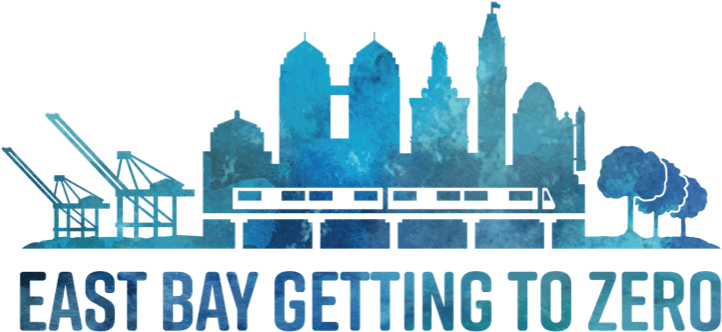COVID rapid tests, PCR tests and treatment are still free in Alameda County, Contra Costa County, Solano County, and other locations in California regardless of insurance or immigration status and after the end of the public health emergency.
If you have symptoms, mask up and do serial antigen testing or get a PCR or other molecular test. Recent data shows that viral loads don’t peak until around Day 4 of symptoms with the Omicron variants. To increase testing accuracy:
- Serial antigen testing is repeat testing every 24 to 48 hours, which has been shown to increase accuracy in picking up infections, especially if asymptomatic. Current guidance is to repeat antigen testing 48 hours after the first negative test before excluding Covid infection.
- PCR and other molecular tests are more likely to pick up early Omicron infections.
Free PCR testing in the East Bay
Free PCR tests are available at the Community Church in Oakland on Tuesdays, Wednesdays and Thursdays 10:00am to 3:00pm at 1527 34th St Oakland, CA 94608. Register here, visit the Community Church website or call 510 594-2207 for more information.
How to get free rapid home tests
Free Covid-19 tests are back on COVIDtests.gov! Starting November 20, 2023, each US household can request 4 free rapid tests through USPS.
Some in-person testing sites offer take-home test kits: Alameda County, Contra Costa County, Solano County, and other locations in California.
Umoja Health Community Hub offers free rapid antigen tests at their North Oakland site at 750 Aileen Street, Oakland 94609, Monday-Tuesday-Wednesday, 10 am to 2 pm, 1-888-763-0007. They offer N95s and other masks, hand sanitizer, rapid antigen tests and printed resources at this location.
Contra Costa residents can get free at-home COVID test kits from Contra Costa Health (CCH) through a new mail-order program. People can order up to 4 free at-home test kits per household by filling out this online form or by calling 833-829-2626. There are two tests in each kit. CCH will mail the kits directly to people’s homes within approximately 5-7 business days. You must be a Contra Costa County resident to be eligible.
If you have health insurance in California, you can get 8 free rapid home tests per month:
- Medi-Cal: Show your Medi-Cal card at a pharmacy and ask for free at-home tests with no co-pay. Click for more details. Medi-Cal coverage for free Covid tests and treatment is guaranteed until at least September 30, 2024.
- Medicare: Coverage for free at-home tests varies by plan. Bring your red, white, and blue Medicare card to a pharmacy to get your free tests. See details at Medicare Covers Over-the-Counter COVID-19 Tests (PDF).
- Private insurance: Insurance must pay or reimburse for 8 at-home test kits per month until November 11, 2023 for California residents. Purchases can be made online, at stores or pharmacies. Receipts are required to request reimbursement. Please go to your health insurance’s website or contact them for details on how to request reimbursement. Find out more about this California policy at How to Get Your At-Home Over-the-Counter COVID-19 Test for Free. Some insurance plans (such as Kaiser) will continue to cover in-network home test kits after November 11, 2023.
- Click to download a PDF on Covid medical coverage changes in California.
When to get tested
Vaccinated or not, here is when to test (aligned with CA guidelines):
- If you have symptoms (see below), test immediately. Test again 1-2 days later if the first test is negative. Assume you have something infectious, wear a mask and stay home when possible.
- If you were exposed, test as soon as possible and repeat 3-5 days after the exposure. For better accuracy, test every 2 days for a total of 3-4 tests, even if you don’t have symptoms.
- Before travel, gathering or returning to school/work, test right before traveling/gathering/return and repeat 3-5 days after.
To improve testing accuracy when you have symptoms:
- If you have symptoms, repeat antigen testing every 24-48 hours through Day 4-5 of symptoms or get a PCR or other molecular test.
- Omicron viral levels rise in the throat before the nose, so consider swabbing the throat before swabbing the nose. Here’s a UK National Health Service throat swabbing video showing how to swab your throat and nose using the same test.
- Recent data shows that viral loads don’t peak until around Day 4 of symptoms with the Omicron variants. This means that antigen tests miss some infections in the first few days of symptoms. This may be because we have accumulated more immunity and are now more likely to have symptoms early in an infection. Another study also suggests that antigen levels might be lower than RNA levels with Omicron infections.
- Lab-based PCR tests are more likely to pick up early Omicron infections.
- Home molecular test kits are also available (Lucira COVID, Lucira COVID+flu, or Metrix COVID test kits), which detect viral genetic material like PCR tests. These home molecular tests are more sensitive and accurate than antigen tests, but they are also more expensive ($25-50 per test).
To improve asymptomatic screening accuracy:
- The FDA guidelines are to test at least 3 times if you don’t have symptoms, about 2 days apart.
- To optimize home testing accuracy, especially when gathering with people at high risk: test the day before, right before gathering, and each day during the gathering.
- Consider swabbing your throat, then nose, like in the UK. Here’s a UK National Health Service throat swabbing video showing how to swab your throat and nose using the same test. Studies have found that Omicron throat specimens were detectable multiple days before nose specimens.
Why test multiple times? Testing multiple times is recommended because:
- For symptomatic people: Data shows that viral loads don’t peak until around Day 4 of symptoms with the Omicron variants. This means that antigen tests miss some infections in the first few days of symptoms. We have accumulated more immunity and are now more likely to have symptoms early in an infection. Another study also suggests that antigen levels might be lower than RNA levels with Omicron infections. Repeat antigen testing or PCR testing is more likely to accurately detect true Covid infections.
- For asymptomatic people: ~63% of people don’t have symptoms when they are first infectious with the Omicron variant, and ~32% don’t ever develop symptoms even though they can infect others.
What are the most common COVID-19 symptoms?
The top 5 symptoms reported with Omicron infections are:
Here is a longer list of common Covid symptoms. These symptoms look like typical cold, flu and/or allergy symptoms, so if you think you might have a cold or new allergies, please test for Covid!
Which test: rapid antigen vs. PCR?
- If you have symptoms, assume you are positive and isolate/wear a good mask. Most people with Omicron infection get symptoms a day or two before viral loads are high enough for rapid tests pick up positive results.
- Do a rapid test to get timely results and check your level of infectiousness. Get a PCR test if you can’t get a rapid test or have symptoms and your rapid test is negative.
- A rapid test positive result is highly accurate for diagnosis of COVID-19.
- Look carefully at the result: even a very very faint test line is a positive result.
- If the rapid test result is negative, isolate/quarantine and repeat the test in 1-2 days.
- If you still have symptoms after two negative rapid tests, test a third time with a rapid test or get a PCR test. A PCR test will pick up lower viral levels (which may be a characteristic of Omicron infections), so get a PCR test if you have symptoms and repeatedly negative rapid test.
- Both rapid and PCR tests will pick up Omicron and other variants, whether you are vaccinated or not.
- Timing matters: rapid tests give you timely information to act upon and are a useful screening tool. A PCR test can take 1-5 days to get a result, and by then the person’s most infectious period may be over. A rapid test will tell you if you are infectious (with a high viral load) within 15-30 minutes.
- Rapid antigen tests are useful for screening for infectiousness right before a gathering (ideally 15-30 minutes before) as well as 3-5 days after an exposure and for screening every 2-3 days.
- Rapid tests accurately pick up Omicron infections with high viral loads.
- Two rapid tests increase accuracy: using a rapid antigen test a day before a gathering and right before a gathering increases its accuracy in detecting a positive result.
- Negative rapid antigen tests can also be used to get out of COVID isolation (when a person is infected with COVID) after 5 days of isolation and symptoms have resolved.
- Expired home tests? If you still get a clear “control” line, the test is likely to still be effective.
- A PCR test will pick up much lower levels of virus for diagnostic and rule-out purposes, but keep in mind it might take 1-5 days to get the result.
- It’s important to wear a high quality mask and distance while waiting for test results, especially if you have symptoms.

Where to get free COVID-19 tests in the East Bay
California residents can still get free testing and treatment regardless of insurance or immigration status. Other East Bay locations with free testing are listed below. PCR tests using nose swab or using saliva (no swabs!) and rapid antigen tests are available.
- Alameda County free COVID testing sites: This webpage includes community-based sites offering free testing for anyone with symptoms, including people without health insurance.
- Contra Costa County free COVID testing
- Solano County free testing sites
- Each US household can click here or call 1-800-232-0233 to request 4 free COVID home tests, with shipments starting December 19, 2022.
- If you have health insurance, you can get 8 free home tests each month.
- If you have a health care provider, school or workplace, check for testing availability with them.
- Please check the listing for updates and call the testing site before you leave to make sure they are open for testing, you are eligible, and register if needed.
- If you don’t have a provider and have COVID symptoms: In Alameda County, call Alameda Health System 510-437-8500 for a phone screen and guidance. In Contra Costa County, call 844-729-8410. In Solano County, the county COVID warmline is 707-784-8988.
- If you’re having difficulty breathing and unstable, please go to your nearest emergency room.
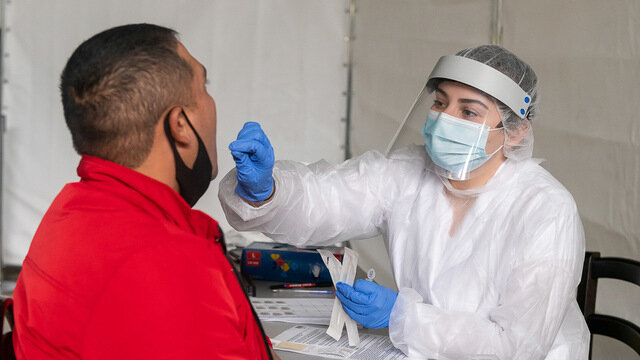
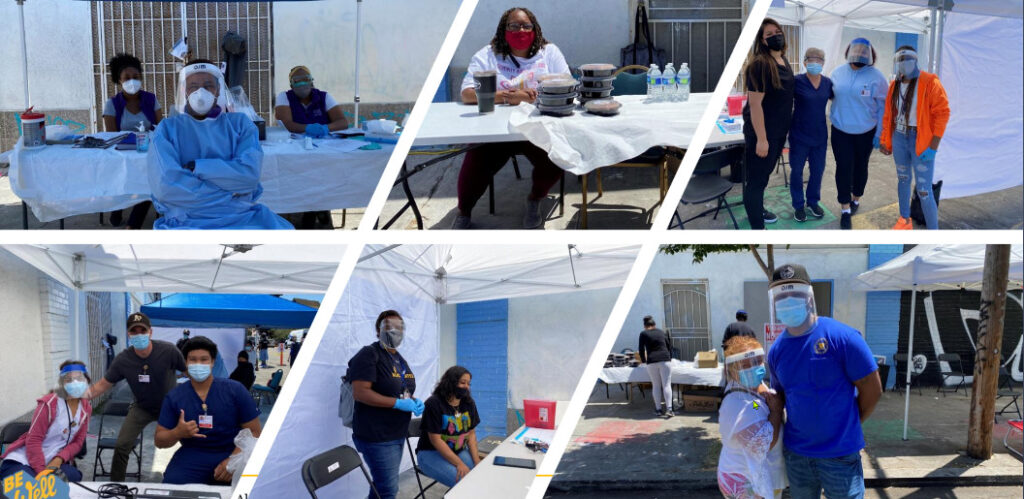
How to check if a testing site is legit:
Sketchy and unauthorized COVID testing sites have cropped up during the winter 2022 surge. Here’s guidance from Alameda County on how to check if a testing site is legit:
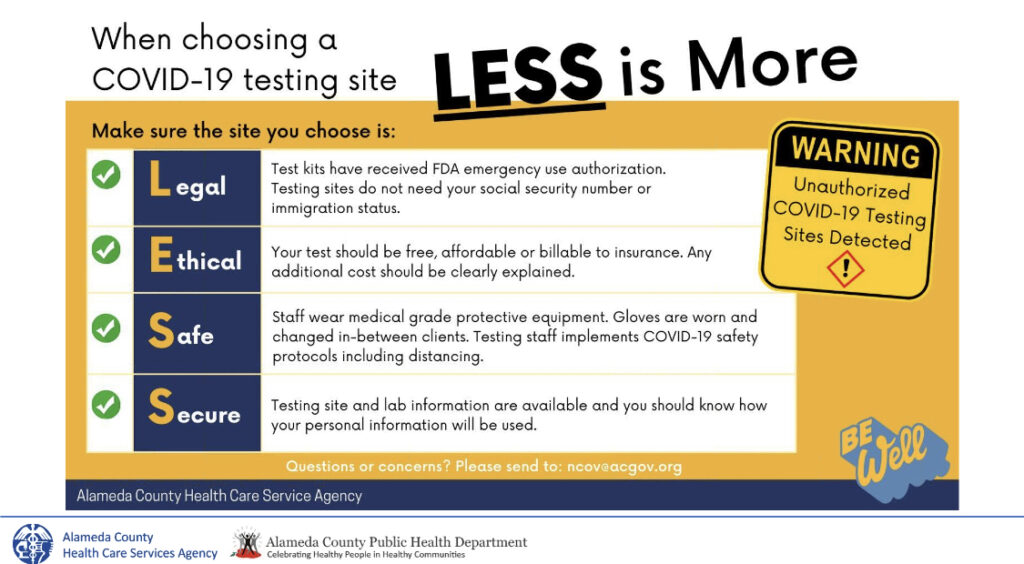
Rapid antigen home tests: more details
- How it works: The rapid antigen home COVID-19 tests detect viral nucleocapsid proteins and provide rapid results in 10-30 minutes for when people are at their most infectious stage. They are effective at picking up high viral loads and are less sensitive than the PCR tests but provide timely results and are cheaper and easier to use. These tests will pick up Omicron and other variants.
- Look carefully at the result: even a very very faint test line is a positive result.
- Omicron seems to replicate rapidly first in the throat before the nose, so some countries (like the UK) and some people have been swabbing their throats before swabbing their noses for the rapid antigen tests (though it’s off-label use since this has not been authorized by the FDA/CDC in the US yet).
- Do not use a cotton swab (Q-tip) for rapid tests! The material in cotton swabs interfere with the test result. Only use the swabs that come with the kits and are intended for rapid testing.
- For screening: Rapid tests are especially useful for screening right before a gathering. Ideally, do the rapid test 15-30 minutes before the gathering. This is because the Omicron and Delta variants spread very rapidly and when people don’t have symptoms.
- For exposures: If you have an exposure, we recommend that you use the rapid antigen test to check for infectiousness 3-5 days after the exposure. Repeat the test in 1-2 days after the first test to confirm a negative result.
- If you have symptoms, assume you are positive and isolate/wear good masks. Omicron infection usually results in symptoms, ~2 days after exposure, about a day before viral loads are high enough for rapid tests to pick up positive results, so it’s important to start isolating, masking and test as soon as you feel symptoms. If you only have 1-2 tests, may want to wait a day or two after your symptoms start to have the greatest likelihood of catching a positive result.
- For leaving isolation: Negative rapid antigen tests can also be used to get out of COVID isolation (when a person is infected with COVID) after 5 days of isolation and symptoms have resolved. Most people remain positive after 5 days, so if you’re still positive, know that it’s quite common.
- For rebound: The return of high viral loads and symptoms can happen with and without treatment, so do a rapid test if your symptoms return and isolate until it turns negative again.
- Expired home tests: If you still get a clear “control” line, the test is likely to still be effective.
- People with insurance can also get up to 8 rapid antigen tests per person per month. Click here for details.
- The CDC has guidance on self-testing and what people should do with test results.
The science behind COVID-19 PCR and antigen testing
Testing and Omicron: listen to this In the Bubble podcast with Dr. Michael Mina and Andy Slavitt to hear Dr. Mina’s expert responses to listener questions around testing and the Omicron variant.
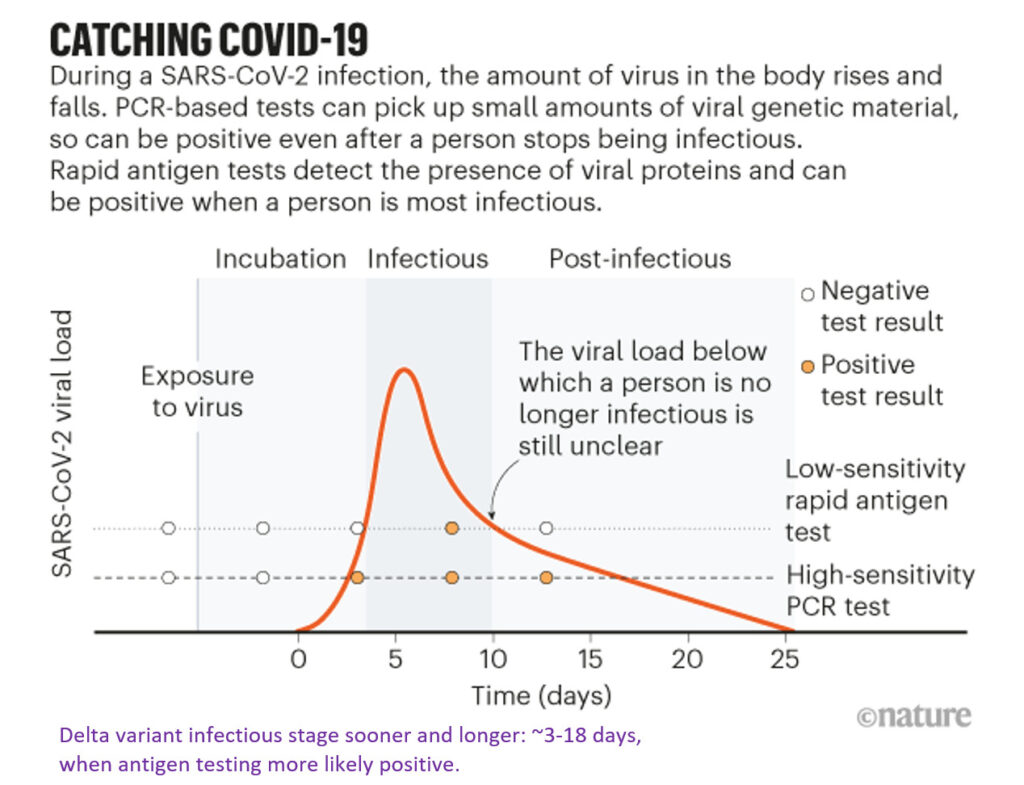
For the delta variant, emerging data indicates that the infectious stage likely begins sooner (2-3 days) and lasts longer (13-18 days). See references below. Rapid antigen testing will be most likely to pick up delta infections starting 3-5 days after exposure and up to about 14 days after exposure in unvaccinated people or about 11 days after exposure in vaccinated people.
Frequent rapid antigen testing every 3-7 days is more likely to catch a delta infection during the infectious period than less frequent PCR testing. Rapid antigen tests are also less likely than PCR test to pick up people who are no longer infectious but are still shedding viral particles. The more frequent the rapid antigen testing (2 times a week or more), the more likely you will detect infectiousness before a person becomes symptomatic or spreads the virus. Frequency of testing is balanced between willingness to test, cost ($10-15 per test in the US), availability and access.
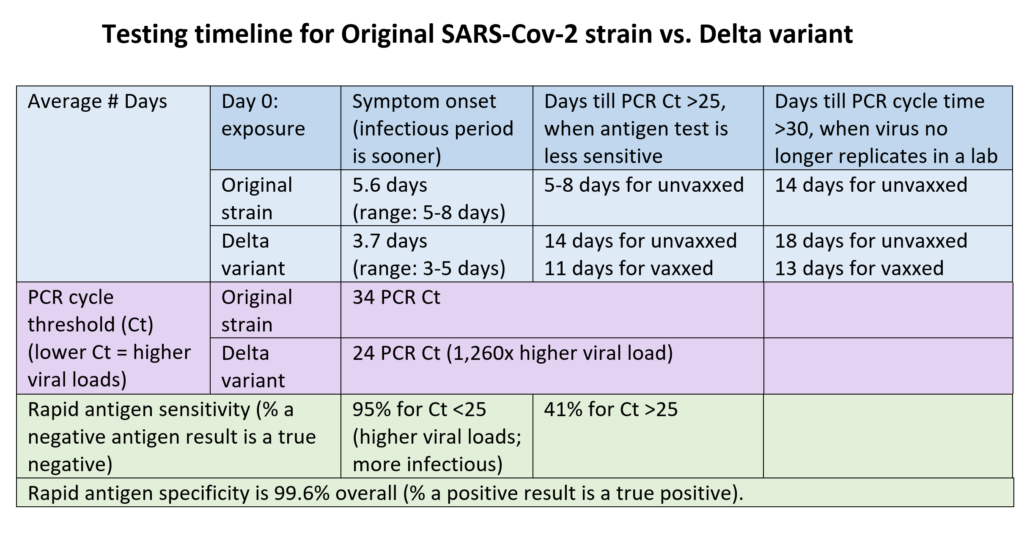
Rapid antigen screening every 3 or 7 days for delta infections
This table illustrates hypothetically how different frequencies of rapid antigen testing (every 3 or 7 days) might detect delta infections during the most highly infectious period (2-18 days after exposure). This table shows how we are more likely to catch infections earlier during the most infectious period with testing every 3-4 days (twice a week) rather than every 7 days (once a week). The green plus symbols (+) show days when infection is caught and the red “O” or exclamation marks (O or !) show days when infection might be missed.
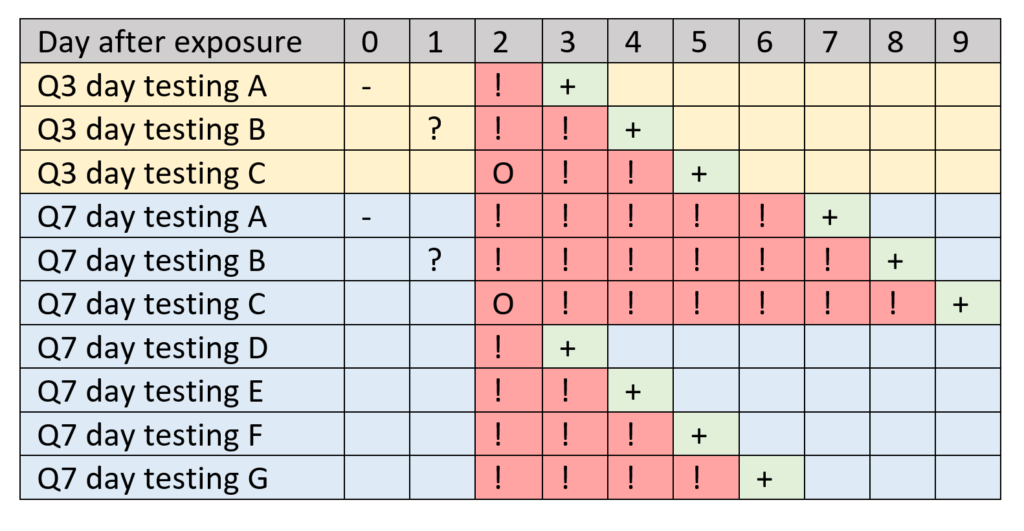
- The dashes (-) mark when the rapid antigen test is performed, is negative, and may be too soon to be in a period of infectiousness.
- The question marks (?) mark when the rapid antigen test is performed, is negative, and we do not have enough data to know if it’s likely to be a day of high infectiousness.
- The red exclamation points (!) mark when the rapid antigen test is not performed because of the testing schedule and thus miss the infection during a likely infectious day.
- The red O’s (O) mark when the rapid antigen test is performed and may miss the infection (pre-symptomatic PCR Ct and viral loads not yet known).
- The green pluses (+) mark when the rapid antigen test is performed and more likely pick up the infection (viral loads expected to be high and PCR Ct expected to be <25).
